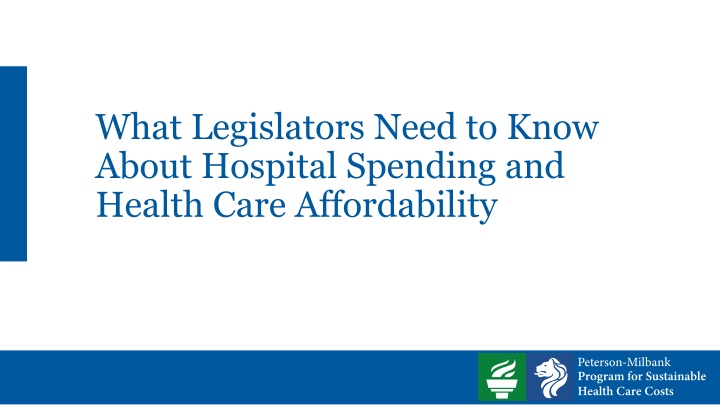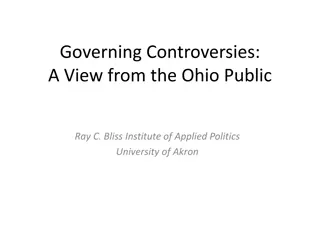
Hospital Spending Impact on Health Care Affordability
Discover the challenges of hospital spending and its impact on health care affordability, drawing insights from real-life examples and data analysis. Learn how hospital costs affect families and explore potential policy solutions to address the growing affordability crisis.
Download Presentation

Please find below an Image/Link to download the presentation.
The content on the website is provided AS IS for your information and personal use only. It may not be sold, licensed, or shared on other websites without obtaining consent from the author. If you encounter any issues during the download, it is possible that the publisher has removed the file from their server.
You are allowed to download the files provided on this website for personal or commercial use, subject to the condition that they are used lawfully. All files are the property of their respective owners.
The content on the website is provided AS IS for your information and personal use only. It may not be sold, licensed, or shared on other websites without obtaining consent from the author.
E N D
Presentation Transcript
What Legislators Need to Know About Hospital Spending and Health Care Affordability
Health Care Affordability Has Reached Crisis Levels Catalina Hernandez, who has worked for Hyatt Regency Monterey for nearly 20 years, and her family faced $20,000 in hospital bills after her husband s cancer surgery. Over the three years it took to pay the bill, her family had to limit groceries, basic household items, and maintenance for the car that she used to commute to work. Testimony, California Department of Health Care Access Hearing, December 2023 Over 80% of employers support both hospital reforms and pharmacy benefit manager reforms. Interest in policy reform surged from 2022 to 2023, with the greatest gains for hospital rate regulation (up 20%), hospital price transparency (up 11%) and surprise billing regulation (up 7%). National Alliance of Health Care Purchaser Coalitions 2023 Pulse of the Purchaser Survey www.milbank.org
Health Care Growing Affordability Crisis Health care costs have grown faster than the economy for decades Rising costs burden pn states, employers, and families COVID reinforced the need to rein in health care cost growth
Hospital Spending Comprises the Largest Share of Per- Person US Health Care Spending www.milbank.org
Price Driving Increased Spending by Service Category HCCI
How Do We Know Hospital Spending Growth Contributes to States Overall Health Costs? Cost driver analysis uses all-payer claims data to identify the major factors contributing to cost growth. This in turn can suggest policy opportunities to slow that growth. States have identified hospital spending and prices as major contributors to cost growth using these analysis. www.milbank.org
Cost Drivers Analysis by Service Category in Rhode Island Shows Hospital Outpatient Spending Was the Leading Commercial Insurance Market Driver Source: OHIC. 2024 Annual Report: Health Care Quality and Spending in Rhode Island.
Understanding Hospital Finances in Your State Hospital financial analysis can: Identify hospitals that are performing better or worse regarding cost growth, community benefit spending, and more Inform implementation of policies like enhanced health care merger review or hospital cost/price growth caps Assess the potential impact of affordability policies on a hospital s financial health www.milbank.org
What Are the Best Public Data Sources for Hospital Financial Analysis? The Guide profiles three publicly available data sources and considerations for use. Hospital Financial Data Source Options 1 2 3 Medicare Cost Reports accessible via: Audited Financial Statements IRS Form 990 Filings National Academy for State Health Policy (NASHP) Hospital Cost Tool (HCT) CMS Healthcare Provider Cost Reporting Information System (HCRIS) Source: Guide to Understanding Hospital Spending through Financial Analysis. Milbank Memorial Fund. April 2024.
Interpreting Audited Financial Statements: Case Studies Audited Financial Statements are useful for analyzing a comprehensive set of financial metrics at the health system level. Case studies provided with the Guide draw data from the Audited Financial Statements of three actual health systems from different regions of the country. Each case study summarizes the state of the health systems finances using eight key financial indicators of profitability, liquidity, and more, and comparing performance on those metrics to reference ranges. www.milbank.org
Case Study: Health System A Health System A s profitability was very favorable compared to the reference range, as was its liquidity. Performance on these metrics is reinforced by its favorable debt capacity, which suggests that the entity was managing cash and debt well. Its performance on the capital investment measure indicates that the health system made significant investments in its property, plant, and equipment. Performance on the age of its facilities and financial burden were within the median range. The financial health of the system is also confirmed by the significant accumulation of unrestricted net assets of approximately $15 billion. These findings suggest that it s unlikely that state cost growth mitigation policies designed to slow the growth of hospital prices would threaten Health System A s financial viability. www.milbank.org
Policies to Target Rising Hospital Costs Legislation to bring down commercial prices may include: Health care consolidation is contributing to rising hospital costs. Stronger market oversight legislation may include: Review and approval of proposed mergers involving hospitals Monitoring of conditions placed on approved transactions involving hospitals Hospital budget review and payment policies may include: State review of hospital budgets (Vermont) Hospital price caps or limits on commercial cost growth (Oregon) State board that ensures that any changes to hospital budgets align with the state s health care spending benchmarks (Delaware) www.milbank.org
Call to Action for Legislators Given that health care is increasing unaffordable and that rising hospital spending is a major cost growth driver: Failure to implement affordability policies will increase the health care cost burden on your state and its residents and employers and limit investment in other sectors like primary care and behavioral health When deciding what evidence-informed actions to take, conduct financial analysis of your state health systems using the tools described www.milbank.org
Read the guide and case studies at: milbank.org/cgt






















